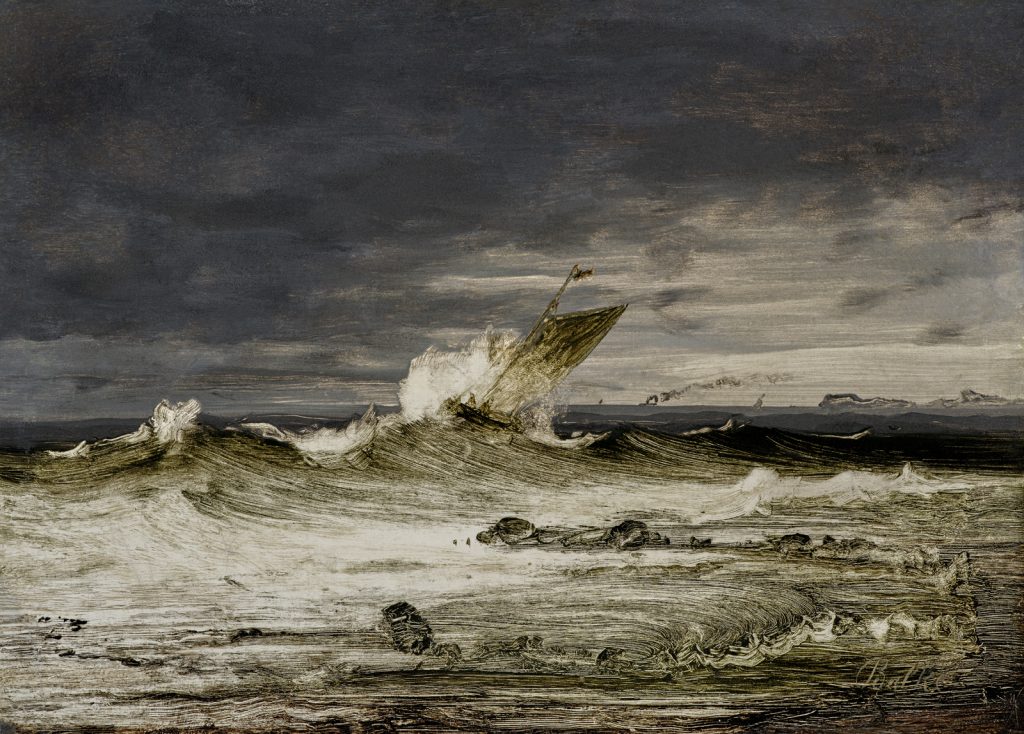Peder Balke
(Hedemarken, Norway 1804 - 1887 Oslo)
Stormy Sea with Sailing Ship in Distress, 1860s
Oil on paper, laid down on cardboard, 17.3 x 23.9 cm
Signed lower right Balke
Bearing a stamp on the verso DEP 666 (inventory stamp Copenhagen, Statens Museum for Kunst)
Provenance:
Karl Balke, Oslo, the artist’s son, 1914;
Possibly with Marie Schioldborg, née Balke, Peder Balke’s granddaughter;
W. Schioldborg, Oslo, 1954;
Galerie Jean-François Heim, Paris, 2001;
Asbjørn Lunde (1927-2017), New York, from 2001, inv. 507.
Exhibited:
Norges Kunst Jubilæumsutstillingen 1814-1914, Oslo, Frognerparken, 1914, no. 24;
Peder Balke. 1804-1887, Oslo, Kunstnernes Hus, 1954, no. 148;
Et dramatisk møte - Ørnulf Opdahl og Peder Balke, Modum, Blaafarvevaerket, 2006, no. 58;
Den ville natur. Sveitisk og norsk romantikk. Malerier fra Asbjorn Lundes samling, New York, Tromsø, Nordnorsk Kunstmuseum and Bergen, Billedgalleri, 2007-8, p. 130, no. 45;
Forests, Rocks, Torrents: Norwegian and Swiss Landscapes from the Lunde Collection, London, National Gallery, 2011, no. 12;
Peder Balke: Visjon og revolusjon, Tromsø, Nordnorsk Kunstmuseum, 2014, no. 42, repr. p. 107;
Paintings by Peder Balke, London, National Gallery, 2014-15, no. 27, repr. p. 89;
Rocks & Rivers: Masterpieces of Landscape Painting from the Lunde Collection, Edinburgh, Scottish National Gallery of Modern Art, April 2015-January 2017;
Peder Balke: Painter of Northern Light, New York. The Metropolitan Museum of Art, April-July 2017 (https://www.metmuseum.org/art/collection/search/690351, accessed January 22, 2019);
Sublime North: Romantic Painters Discover Norway. Paintings from the Collection of Asbjørn Lunde, Hartford, Wadsworth Atheneum Museum of Art, September 2017-January 2018.
In 1914, a major exhibition of Norwegian art was held at the Frogner Park in Oslo to mark the centenary of the founding of the Norwegian Constitution. The exhibition brought together work by both contemporary and deceased Norwegian artists. Peder Balke was represented with ten paintings. One of these was the present Stormy Sea with Sailing Ship in Distress. On Balke’s death in 1887 the work passed to his heirs and remained with them. Its first public showing was at the centenary exhibition in 1914.
Balke’s late work, of which this painting is a fine example, clearly establishes his reputation as a pioneer of modernism. In the late 1850s he began to adopt highly unconventional techniques, favoring a wet-in-wet technique or rubbing diluted paints onto the surface of the image with a sponge or the tips of his fingers. By restricting the palette to purplish-blue and green-black he emphasizes the terrible, menacing power of the storm. A recurrent theme in his work is man’s unceasing confrontation with the forces of nature. Nature’s wrath and man’s impotence are symbolized here in his depiction of the storm-tossed ship battling alone against the relentless fury of the sea. While the paint was still wet he dabbed the freshly painted area of the sailing ship with his finger to remove pigment and lighten it – his fingerprint is clearly traceable.

